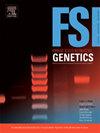司机还是乘客?使用贝叶斯网络评估致命车祸中的 DNA 结果。
IF 3.2
2区 医学
Q2 GENETICS & HEREDITY
引用次数: 0
摘要
本文介绍了一个案例,该案例的问题是确定在一起涉及两人(其中一人在事故中死亡)的致命车祸发生时,谁是司机,谁是乘客。两人是否在车内并无争议,有争议的只是导致 DNA 沉积的机制(即活动)。据我们所知,很少有案件在评估时考虑到被指控的活动。究其原因,包括缺乏知识和数据,以及在得出结论时遇到的困难。在本案例报告中,我们介绍了贝叶斯网络(BN)的结构,该网络用于评估从方向盘、驾驶员和乘客安全气囊中提取的 DNA 检测结果。我们考虑了以下命题:"事故发生时,相关人员(POI)正在驾驶汽车,而替代人员(AP)是乘客 "或反之亦然。我们将讨论所做的假设,以及如何使用文献中的数据将其参数化为 BN。最终得出的似然比为 90。向授权机构提出的声明表明,根据我们所掌握的信息,如果事故发生时是由 POI 驾驶汽车,而不是由 AP 驾驶汽车,那么我们的观测结果的可能性要高出 90 倍。我们进行了一项敏感性分析(5000 次模拟):结果表明,我们的似然比是稳健的。本文章由计算机程序翻译,如有差异,请以英文原文为准。
Driver or passenger? Use of a Bayesian network for the evaluation of DNA results in a fatal car accident
This article presents a case where the issue was to determine who was the driver and who was the passenger at the time of a fatal car accident involving two persons, one of whom died in the accident. The presence of the two persons in the car was not contested, only the mechanisms that led to the deposition of the DNA (i.e., the activities) were. To our knowledge, few cases are evaluated considering the alleged activities. The reasons for this include the lack of knowledge, and data, as well as the difficulties encountered for the formulation of conclusions. In this case report, we present the architecture of the Bayesian Network (BN) used to evaluate the DNA results of the traces recovered from the steering wheel, driver's and passenger’s airbags. The following propositions were considered: “The person of interest (POI) was driving the car and the alternative person (AP) was the passenger at the time of the accident” or vice versa. We discuss the assumptions that were made and how data from the literature was used to parametrize into the BN. A likelihood ratio of the order of 90 was finally assigned. The statement proposed to the mandating authority indicated that, given the information that was made available to us, our observations were of the order of 90 times more probable if the POI was driving the car at the time of the accident rather than if the AP was. A sensitivity analysis was performed (5000 simulations): this shows that our likelihood ratio is robust.
求助全文
通过发布文献求助,成功后即可免费获取论文全文。
去求助
来源期刊
CiteScore
7.50
自引率
32.30%
发文量
132
审稿时长
11.3 weeks
期刊介绍:
Forensic Science International: Genetics is the premier journal in the field of Forensic Genetics. This branch of Forensic Science can be defined as the application of genetics to human and non-human material (in the sense of a science with the purpose of studying inherited characteristics for the analysis of inter- and intra-specific variations in populations) for the resolution of legal conflicts.
The scope of the journal includes:
Forensic applications of human polymorphism.
Testing of paternity and other family relationships, immigration cases, typing of biological stains and tissues from criminal casework, identification of human remains by DNA testing methodologies.
Description of human polymorphisms of forensic interest, with special interest in DNA polymorphisms.
Autosomal DNA polymorphisms, mini- and microsatellites (or short tandem repeats, STRs), single nucleotide polymorphisms (SNPs), X and Y chromosome polymorphisms, mtDNA polymorphisms, and any other type of DNA variation with potential forensic applications.
Non-human DNA polymorphisms for crime scene investigation.
Population genetics of human polymorphisms of forensic interest.
Population data, especially from DNA polymorphisms of interest for the solution of forensic problems.
DNA typing methodologies and strategies.
Biostatistical methods in forensic genetics.
Evaluation of DNA evidence in forensic problems (such as paternity or immigration cases, criminal casework, identification), classical and new statistical approaches.
Standards in forensic genetics.
Recommendations of regulatory bodies concerning methods, markers, interpretation or strategies or proposals for procedural or technical standards.
Quality control.
Quality control and quality assurance strategies, proficiency testing for DNA typing methodologies.
Criminal DNA databases.
Technical, legal and statistical issues.
General ethical and legal issues related to forensic genetics.

 求助内容:
求助内容: 应助结果提醒方式:
应助结果提醒方式:


